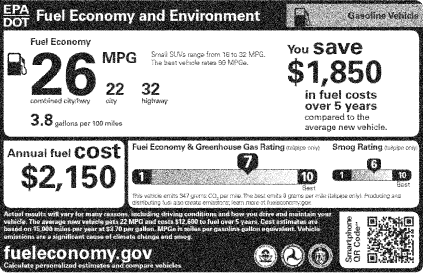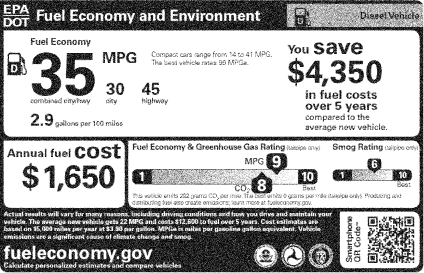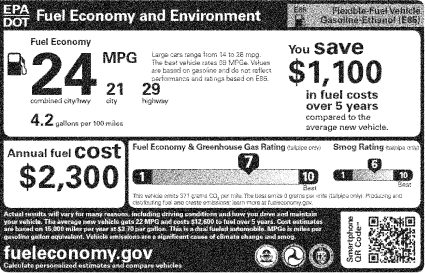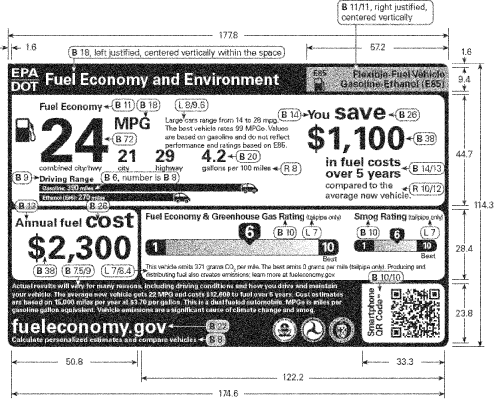Appendix VI to Part 600 - Sample Fuel Economy Labels and Style Guidelines for 2013 and Later Model Years
40:32.0.1.4.44.6.13.9.37 : Appendix VI
Appendix VI to Part 600 - Sample Fuel Economy Labels and Style
Guidelines for 2013 and Later Model Years
This appendix illustrates label content and format for 2013 and
later model years. Manufacturers must make a good faith effort to
conform to these templates and follow these formatting
specifications. EPA will make available electronic files for
creating labels.
A. Gasoline-Fueled Vehicles, Including Hybrid Gasoline-Electric
Vehicles With No Plug-In Capabilities

B. Gasoline-Fueled
Vehicles, Including Hybrid Gasoline-Electric Vehicles with No
Plug-In Capabilities, with Gas Guzzler Tax

C. Diesel-Fueled
Vehicles, Including Hybrid Diesel-Electric Vehicles with No Plug-In
Capabilities

D. Dual Fuel
Vehicle Label (Ethanol/Gasoline)

E. Dual Fuel
Vehicle Label (Ethanol/Gasoline) with Optional Display of Driving
Range Values

F. Hydrogen Fuel
Cell Vehicle Label

G. Natural Gas
Vehicle Label

H. Plug-in Hybrid
Electric Vehicle Label, Series PHEV

I. Plug-in Hybrid
Electric Vehicle Label, Blended PHEV

J. Electric
Vehicle Label

K. Style
Guidelines
(a) Fuel economy labels must be printed on white or very light
paper. Any label markings for which colors are not specified must
be in black and white as shown. Some portions of the label must be
filled with a blue or blue-shaded color as specified in subpart D
of this part. Use the color blue defined in CMYK values of
40c-10m-0y-0k, or it may be specified as Pantone 283.
(b) Use a Univers font from Adobe or another source that
properly reproduces the labels as shown in the samples. Use Light
(L), Roman (R), Bold (B) or Black (Bl) font weights as noted. Font
size is shown in points, followed by leading specifications in
points to indicate line spacing (if applicable). Use white
characters in black fields; use black characters in all other
places. Unless noted otherwise, text is left-justified with a 1.6
millimeter margin. Some type may need tracking adjustments to fit
in the designated space.
(c) Use the following conventions for lines and borders:
(1) Narrow lines defining the border or separating the main
fields are 1.6 millimeter thick.
(2) Each rectangular shape or area, including the overall label
outline, has an upper left corner that is square (0 radius). All
other corners have a 3.2 millimeter radius.
(d) Fuel and vehicle icons, range and slider bars, and agency
names and logos are available electronically.
(e) The following figures illustrate the formatting
specifications:


[76 FR 39570, July
6, 2011]